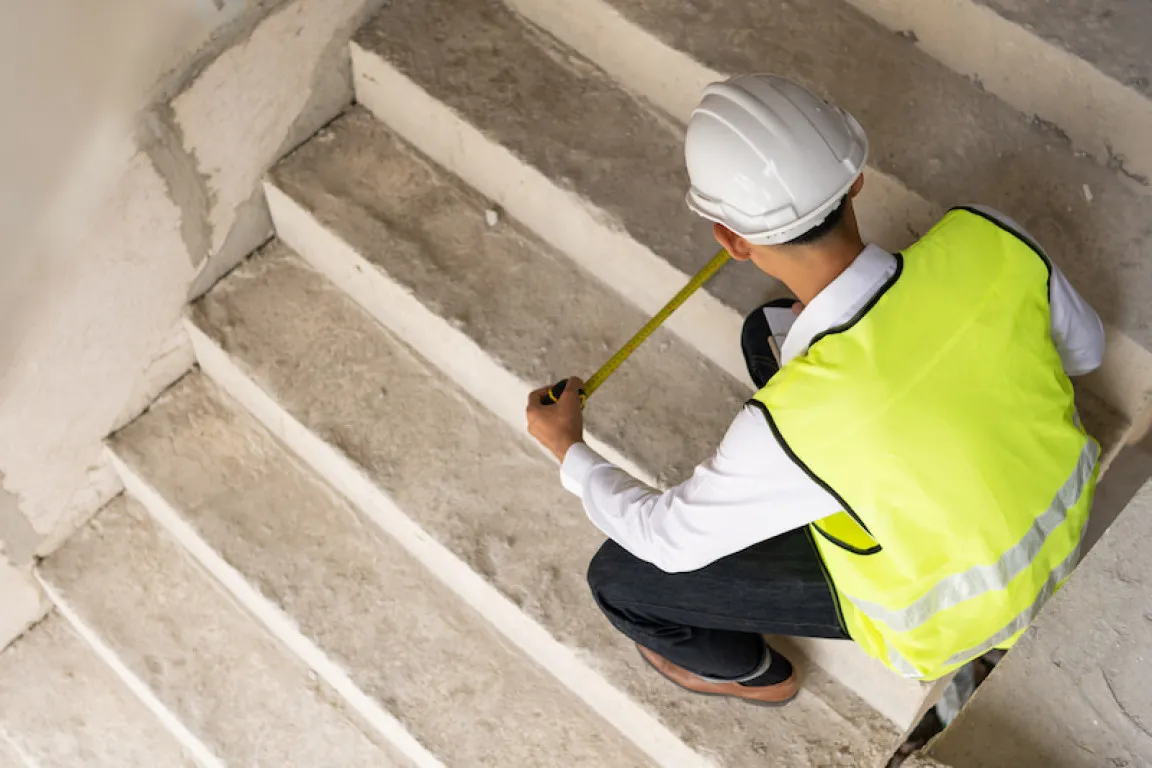A staircase is crucial to high-rise building structures since it connects each floor. Aside from its vital function, the correct staircase design ideas will affect your family's comfort and safety. One of the most important aspects of planning a staircase is calculating the number and size of steps correctly.
Calculating the right steps can help you avoid injuries due to too high or too low stairs. Hence, this article will discuss how to calculate the stairs correctly to ensure they are safe and comfortable. Check out the complete information below!
Parts of Staircase
Before you learn how to measure stairs, it is important to know the parts first to make the calculation correct based on the construction needs and understandably. Below are some parts of the staircase you should know:
1. Stringer Fascia
The stringer fascia is a flat, sloping surface that forms the steps of a staircase. As the main component of a staircase, this part has a very important role. Its sloping shape functions as a foothold for every step you take when going up or down the stairs. It also functions as the main support for your body weight when using the stairs.
Given its crucial function, you must choose a strong material to build stringer fascia, such as steel, reinforced concrete, or hardwood are common choices. These materials are chosen because they can withstand quite heavy loads to ensure the users’ safety.
2. Stair Treads
Stair treads are the next important part of a staircase. They function as footrests located on the horizontal edge at the foot of the stairs. This part helps you go up or down the stairs easily. Because of its vital function, stair treads must be designed with the right distance to ensure comfort and safety.
3. Railing
Stairs should be equipped with handrails to maintain balance or so-called railings. In general, railings are handrails installed on the left and right sides of the stairs to provide support for greater safety when going up or down the stairs. Usually, railings use wood or metal materials.
4. Baluster
The function of the baluster is almost the same as the railing, which is for safety. The baluster consists of vertical components that are tightly arranged between the railings. It also functions as a barrier or fence on the side of the stairs. Baluster is very important, especially in homes with children because it prevents them from falling off the stairs.
5. Riser
Another important part of the stairs is the riser. A riser is a vertical part that connects one stair tread to another. Although not stepped on, the riser is a crucial element that affects the comfort of using the stairs.
6. Landing Tread
The last part of the stairs is the landing tread, but not all stairs are equipped with this element. The landing tread functions as a temporary resting area on several levels of stairs, especially on stairs that have bends.
If the stairs in the house are designed straight, the landing tread is certainly not needed. Due to being big sized, many people use the landing tread as a place to put decorations, such as ornamental plants.
How to Measure Stairs with a Landing Tread
In building stairs, you must use the right formula for calculating steps to make them comfortable and safe to pass through. Here is the formula:
Number of steps = (h:t)-1
Description:
h: total height of the stairs.
t: height of each step (stair tread).
This formula can be applied when calculating the number of steps on an L-shaped staircase with a landing tread.
For example, you will build a staircase with a height of 3 meters and a step height of 17.5 cm. Thus, here is how to calculate 3-meter high steps with the formula above:
- Overall height of stairs = 3 m (300 cm)
- Height of steps = 17.5 cm
- With the formula (300:17.5)-1, the result is 16.14.
Since the number of steps must be an integer, the result is rounded up to 16 steps.
Based on the book Ide Desain Tangga Rumah Minimalis by Tjahjono Tri, the number of steps can be adjusted to the width of the house. In his book, the recommended stair size is 25-30 cm wide, 90 cm long, and 15-18 cm high, with the number of steps between 15 and 20.
Furthermore, if the number of steps on one path exceeds 36, it is recommended to add at least one nosing or landing tread to make the stairs remain comfortable. To calculator landing tread, you can use the formula below:
Hb = 2 x h + 0,15 m
Description:
Hb = Height of landing tread (cm)
h = The height of the riser (cm)
For example, the height of the riser is 20 cm. To find out the appropriate landing tread height, the calculation is as follows:
2 x 20 cm + 0.15 m = 55 cm
So, the ideal landing height for steps with a certain riser is 55 cm.
Stair Comfort Standards
In addition to knowing how to measure stairs, you must understand the ideal stair size standards based on several aspects. Here is a brief explanation:
1. Staircase Slope
The ideal staircase has a slope between 30 to 45 degrees. Many people choose stairs with a 30-degree slope because they feel the most comfortable. Conversely, stairs with a slope that is too steep (more than 45 degrees) or too declivous (less than 30 degrees) will feel less comfortable to use.
2. Staircase Width
The width of the stairs is one of the important aspects that must be considered carefully when designing a building. Generally, stairs have a width of between 90 and 120 cm, depending on the needs and function of the room.
To ensure comfort and safety, the width of the stairs should be no less than 80 cm. This width is considered sufficient to support user mobility, especially in houses or buildings with limited space.
3. Riser Length
Ideally, the riser should have a height of between 15 to 18 cm. If the stair riser is too low or too high, it will disturb the usage. Moreover, the right riser size is very important to prevent the risk of accidents, especially if there are children at home.
Those are the information about how to measure stairs. Accurate calculations will produce comfortable, safe, and aesthetic stairs. Keep in mind that stairs not only function as a connection between floors, but also as a design element that can beautify your home. Therefore, careful planning before starting to build stairs is very important.
Along with determining the number, size, and design, you also need to ensure that the stairs built are sturdy and durable. For this, high-quality cement is needed in the process of building stairs.
Good cement will provide strength and stability to the structure of the stairs to avoid cracks or damage in the future. By choosing the right cement, you not only get a safe and functional staircase, but also make it stronger, more durable, and aesthetic.
One of the best cement choices for making stairs is Semen Merah Putih Watershield. Known for its high quality, Semen Merah Putih Watershield is a multi-purpose premium cement equipped with Water Repellent technology to provide extra protection to buildings.
Unlike ordinary cement, Semen Merah Putih Watershield provides Triple Protection to buildings, protection against leaks from three sources (outside, inside, and from the ground), making buildings stronger, more durable, and requiring minimal maintenance.
Want to know more about Semen Merah Putih? Contact us now for further information about its benefits for your staircase!



